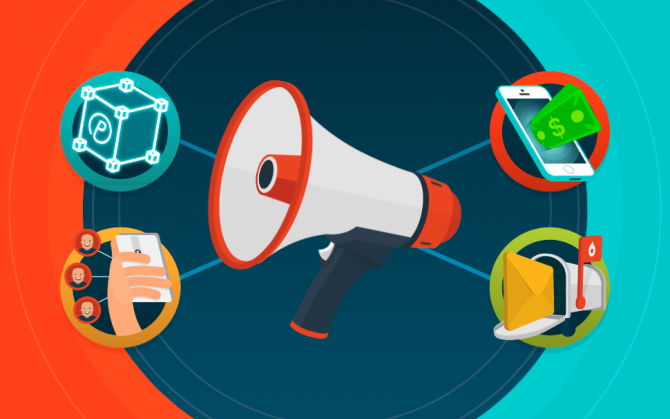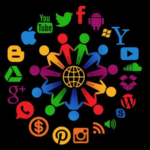At first glance, people may think that marketing is advertising. Attention! Your role will be to defend and position the true concept.
Therefore, we want you to get more resources and arguments to preserve the importance of this term.
Today we will dig deeper into this ecosystem through the types of marketing that exist and which examples will strengthen your knowledge.
What are the 3 most common areas of marketing?
First let’s look at the simple definition of the marketing process in the following sentence:
“…It is the art and science of identifying, winning, retaining, retaining and developing customer value through the creation, communication and delivery of superior value.”
Philip Kotler
Having mentioned this, let’s move on to the 3 most common and active areas that make up marketing management:
Market research: this area involves gathering and understanding data about the market and consumers. The relevant information you can get from this process is the behaviors, needs and wants of the audience. In addition, you will be able to know exactly how they perceive the brand.
There are several instruments to carry out this market research:
- Online / offline surveys
- Interviews
- Sales analysis
- Focus groups
Follow the following tools to carry out this process:
Google keyword planner
- Semrush
- Google Analytics
- Similar Web
- Statista
Definition of the objectives: in this area the company will plan how it will achieve and fulfill the proposed goals to reach the strategies, it is a comprehensive plan that guides the different actions.
Clearly setting the objectives and describing which strategies are the most appropriate will be of dedication.
Here are some tips to help you create them:
- The statement of objectives should be transparent and concise.
- Separate the quantitative from the qualitative.
- They must be concrete in terms of time, be specific in the period they are intended to be implemented and fulfilled.
- Defining types of objectives will help you have a clearer picture.
Communication and promotion: focuses on how a brand communicates with the audience. You can include public relations, social networks, content marketing, any action that aims to visualize and position the company.
The purpose of this area is to convince users to buy that product/service.
These are several models to apply the above:
- Advertising
- Sales promotion
- Sponsorship
10 Definitive Types of Marketing
This, which is the main topic of the Blog, is focused on 11 types of marketing that you can implement to grow your business, your venture or why not take some insights (perspectives) to strengthen your professional experience.
The interesting thing about this section is not only to explain what the definitive marketing models are, but to go into detail and learn about their characteristics.
Traditional / offline marketing
This model groups all the actions that are outside the digital, the online.
Here we consider mass media such as billboards, television, radio and print media.
It requires a higher investment, but there are activities that do not require so much budget, such as merchandising that still gives good results without affecting the “pocket” of the companies.
Attributes:
- Some techniques used are spontaneous calls, sponsorship of events, flyers or flyers.
- It aims to find occasional contact with potential customers and clients.
- Its focus is to generate positioning and remembrance.
- It has a wider reach, but less focused.
- It seeks to increase sales at specific moments.
Digital marketing (our favorite)
The most powerful today, because you will find dynamic spaces to connect and interact with the audience. For example: in ads, blogs, emails, whatsapp messages, networks or influencer marketing.
Their main objective is to promote companies, position products/services with the use of online tools and sell. This can be a challenge for companies, but in truth, it is an advantage to reinforce the brand and generate multiple business opportunities.
An additional fact to convince you to use this type of marketing: 93% of purchase decisions are influenced by social networks.
Attributes:
- It is easy to measure and low investment.
- It allows audience segmentation.
- It has an infinite number of tools to optimize and measure its process.
- Integration with consumers and their needs.
- It has a diversity of strategies that can bring effective results, for example: email marketing, search marketing (SEM), content marketing and marketing automation.
Content marketing
Well, everything in that field is based on content, so it is fundamental to have it on the radar and it aligns very well with the inbound marketing methodology.
Creating content that is not only commercial, but informative, educational or social, alleviates the future customer’s pains, the solution to their problem.
With this you may think that you are giving away your knowledge or your work and that is not the case. It is about giving the user the option to be informed and then, this requires more data or an expert on the subject to initiate further contact.
There are many ways or elements that can be used to disseminate these contents, for example:
Blog: this website is the best way to get traffic to your page and if you do it with good SEO (Search Engine Optimization) strategies it will be very effective.
Educational material: its main function is to offer a wide range of valuable and educational content. Some examples are: ebooks, guides, free courses and interactive material.
Webinars: one of the most popular formats in content marketing, this is usually digital and offers users the solution to a problem or doubt.
Attributes:
- It focuses on the generation of content to solve pains.
- It is a reliable source of information.
- Its distribution can be through different formats and channels (newsletters, for example).
- The creation of personalized content gives brands the opportunity to generate trust and authenticity.
Emotional Marketing
Emotions play a very important role and this factor makes us different from other species. Emotional marketing is in charge of analyzing these behaviors in order to incorporate the best promotional strategies.
Its main purpose is to satisfy consumers in order to obtain a positive reaction and feedback towards the brand. In short, to create an affective bond between consumer and brand.
Attributes:
- Emotion and profitability go hand in hand.
- It is important that all strategies in this type of marketing be oriented to experiences, sensations and emotions.
- It helps to humanize the brand.
- It has the ability to attract and fall in love with its target audience, the concept of lovemarks (love brands) is born.
Guerrilla marketing
This concept may sound a little strong, but it is the connotation of marketing, it is about acting with cunning. One of its specific actions is the intervention in a public area to make a message known in an impactful way.
At the same time, it tries to generate a memorable experience for passers-by thanks to creativity. Undoubtedly, it is a different kind of advertising that requires originality and persistence.
It must be kept in mind that it is not just about placing an advertisement, but of attracting attention at its best.
Attributes:
- Generate attention and surprise.
- Use unusual tactics.
- Positions the brand with minimal investment.
- An innovative facet of the company is evident.
Experiential marketing
This is known as marketing that focuses on producing a unique and remarkable experience for the user.
The most important thing that makes it important in our list is because it focuses on the customer, not the brand or the product.
If you’ve seen it, in different advertisements or promotions, companies are able to stimulate the audience’s senses in a positive way, generate unforgettable experiences, which is why it leads them to buy and remember the brand. That is what this type of marketing is dedicated to.
Attributes:
- Consolidates emotional and positive connections among the public.
- Drives customer participation in mass activities.
- Implements storytelling to excite and move.
- Increases brand relevance.
Branding Marketing
Branding (brand personality) is a whole universe to build a brand and connect with customers.
We can’t forget to work and give focus to the brand, as most of the time we forget this as we focus on audience-oriented marketing.
And yes, it can be difficult to measure sales volume in this model, but it does add up in the process.
This type of marketing if applied to all businesses will succeed in building trust around the brand. Eighty-one percent of consumers buy from the brand that builds trust.
Elements of branding:
-A purpose
-Logo and slogan
-Visual identity
-Communication tone
-Personality
-Product features
-Brand experience
Reaching the audience’s mind and heart is the primary goal of branding.
5Attributes:
- Promotes not only the product but also the value creation of the company.
- Have a personality and purpose (corporate identity).
- Its success can be measured through metrics such as customer loyalty, increased sales and company perception.
- It helps differentiate a brand from its competition.
- There is no denying that branding is the differentiation strategy for your business.
Marketing with influencers
This strategy associates brands with well-known people in digital platforms or media, also called influencers.
This method has grown like foam due to the ability to communicate the product/service to a specific niche, it can be with the production of content, mass campaigns through challenges; in itself they become agents of the brand.
We cannot fail to mention the role of microinfluencers who have come to support SMEs to have greater dissemination and positioning in the market.
Attributes:
- It guides its strategy through collaborations with influencers.
- Social networks and online community are her favorites.
- It is accessible to any brand.
- It allows a precise investment that guarantees an effective return.
Neuromarketing
It is the combination between neuroscience and marketing.
It is based on understanding how the user chooses a brand, what goes through his brain when deciding to buy.
Neuromarketing studies some brain processes, combining the attention and emotion of the public.
The main types of this discipline are: visual neuromarketing, auditory neuromarketing and emotional neuromarketing.
Which one catches your attention the most?
Attributes:
- Data-driven and analytics-based.
- Seeks to understand the actions that lead to the purchase decision.
- It facilitates the interaction between brand and customer under their behavior patterns.
- Its execution is very precise, therefore, so are the results.
Green marketing
Purely environmental marketing. It is also known as ecological marketing (green marketing), since its focus is to determine commercial strategies dedicated to the sale of products that reduce the negative impact on the environment.
More than a type of marketing, it is a movement that was created due to the concern for the increase of affectations to the planet.
This is a favorable option for companies that want to bet on raising awareness of the use of elements that can affect the environment.
Attributes:
- Creates awareness of the environmental impact that companies have.
- Notifies the use of products that do not affect the environment.
- Benefits companies that want to attract customers who prefer to buy healthy products.
- Helps educate and engage users to make the world a better place.
Whew what a way to go! Yes, we have made progress
There is still a lot of “fabric to be cut”, there are quite a few types of marketing, but we feel these are the most appropriate for brands to implement.
Tip: don’t worry, you don’t have to tackle them all, the important thing is that you prioritize according to your needs and that they are best aligned with your company’s objective.
Five examples of successful marketing types
Since there are different types of marketing, we want to focus on the 5 examples of the most applied models in companies.
Each plan is different, so we are going to share with you the most effective and successful referents.
Disneyland
Users connect in a positive way, because of what this brand represents in the history of children in the world.
The Disneyland in Paris launch commercial is a clear example of stirring all emotions, of making the skin crawl when watching and listening to it.
It uses all the techniques of emotional marketing, creating a connection between young and old with the brand in a close and inspiring way.
L’Oreal Paris
The beauty products brand shocked its followers on social networks with the promotional commercial of one of its lipsticks that paints the streets while being moved by a car.
Although the video looks so real, the use of 3D rendering and artificial intelligence won over users.
Here we see the implementation of the characteristics of the guerrilla marketing model, but evolved, using digital channels and current technological tools.
Lego
When we see a piece of this brand, we are transported to that famous playful toy. This is thanks to the branding and identity construction that has maintained its worldwide recognition.
Lego has been able to combine colors, logo, design and marketing strategy focused on its brand to convey values related to fun and family time.
Burger King
This brand connects its audience in a discreet way using a combination of trending topics or the seasons of the year and its products through social networks.
The fast food chain is very clear about who its Buyer persona is, what their preferences are and what their preferred digital platforms are.
For example, the brand took advantage of the Halloween season, a period that activates sales, to design its social media posts using a fun and friendly tone in the messages in combination with its products.
This is a perfect strategy for the attraction stage of the marketing funnel.
Electoral campaign
This is the institutional process in which citizens vote for candidates who will occupy public office and who, through interruption marketing or traditional marketing, convince the public to vote for them.
During these campaigns, traditional media such as television, radio and newspapers are used. The most allusive are billboards.
What they intend with this practice is to constantly persuade the audience with a purpose.
And… to conclude…, what impact do the 4 P’s have on marketing?
The term 4 P’s, also known as the marketing mix, has had a very interesting impact since it was created by Professor Jerome McCarthy in 1960 and later promulgated by the father of marketing, Philip Kotler.
The 4 P’s represent the pillars of a marketing strategy and are divided into four concepts which are: Product, Price, Promotion and Place. These are the set of variables that allow companies to plan and execute marketing actions.
The digital world has evolved by leaps and bounds and of course the 4P’s have also been transformed.
Now they are called the 4C’s (Customer, Cost, Coexistence and Communication), a concept designed by Professor Robert Lauterborn. Here the prominence of the product is left aside to give relevance to the audience.
That said. Now we see the impact that this marketing concept has had in the digital era, but from the perspective of artificial intelligence: a technology that mimics human intelligence to perform activities or improve them through software.
- Product: companies are using this tool (AI) to personalize their products/services. For example, knowing the customer’s needs from a specific item, which allows the brand to adapt its offer to the consumer’s preferences.
- Pricing: artificial intelligence can simulate to the company an appropriate price for its product/service, which is in line with the current market situation. This allows brands to maximize their profits.
- Square: from this point, AI can help companies consolidate their physical and digital channels with the purpose of giving the customer the ease of contacting the brand. Mobile apps, virtual catalog options and online sales come into play here. All of these will enhance the user experience.
- Promotion: Artificial intelligence tools play a very important role in this phase, as they can be configured to produce attractive and dynamic content, clearly tailored to the target audience. For example, AI can generate ads or be used to analyze and optimize advertising campaigns in real time.
The interesting thing about the evolution of the traditional 4Ps integrated with artificial intelligence is that it not only improves customer satisfaction, but also increases the efficiency of marketing processes and offers solutions to make better decisions.















